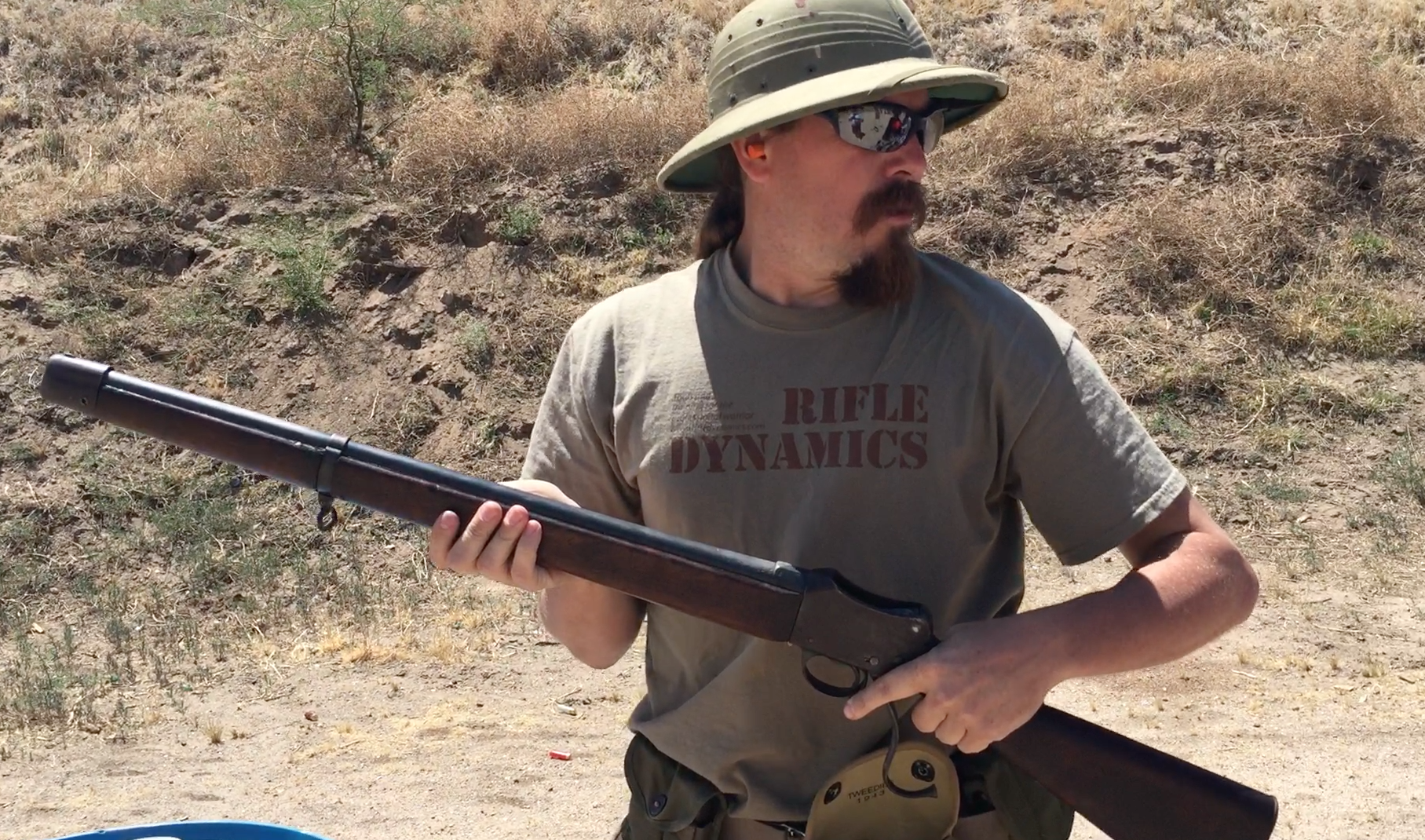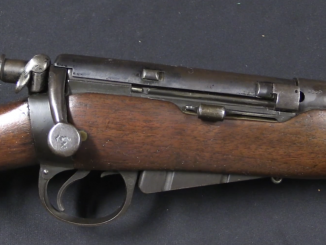These are lots #558, 559, 1585, 1586, 3535, and 3536 in the upcoming RIA Premier Auction. It was scheduled for April, but has been postponed – check their web site for upcoming Online Only auctions every month, though!
Today we are taking a look at the different variations in .455 caliber Webley-Fosbery automatic revolvers. The two main types are the Model 1901 and Model 1903 (the Model 1902 was the very rare .38 caliber version). The main change between the two is the change from a coil mainspring to a V mainspring, to improve reliability when dirty; done in response to British military testing. In addition the 1903 has an improved fire control mechanism, a lower hammer profile and a new cylinder removal system.
Within the Model 1903, there is also a change from a standard frame and cylinder to shortened versions of both. These changes occurred at about serial number 3350, in 1912. The shortened cylinder was made to fit the new Webley MkII ammunition, which was notably shorter than the MkI type – and a shorter cylinder reduced weight.




I made a cup of strong tea with milk British-style per Mr. Ferguson’s advice, and sat down to watch this. There’s some Walker’s shortbread to go with, but that’s Scottish. In “The Maltese Falcon” Sam Spade identifies the murder weapon in detail: “Webley-Fosbery automatic revolver. Thirty-eight eight-shot. They don’t make ’em anymore.” I read that as a teenager and thought Hammett, the author, was making it up. Now I think he was burlesquing the drawing-room mystery of the day with its hand-tooled rare dueling pistols, by naming the most obscure revolver in the world. Yes, Virginia there really was …
Thanks again to Mr. McC, Scottish heritage and all, for this info.
It’s amazing how many “automatic revolvers” showed up in adventure and detective fiction after that. 🙂
Additionally Webley-Fosbery can be used as evidence that describing revolver with manual safety is compatible with real world.
While I believe in “simple, practical, and proven,” I also enjoy historical “What if?”s. It would be fascinating to see a modest-pressure revolver combined with the curved-travel (and therefore, presumably, moderately delayed) blowback idea experimented with in that era. It could permit a much higher hold relative to bore axis, with the block and much of the hammer rolling into the grip:
-Ignition. Cartridge case recoils out the back of the cylinder against inertia of rolling block, compressing recoil and hammer springs.
-Case, deflected up or right by block, ejects rearward past shooter. Hand advances cylinder (in conventional, not W-F, revolver fashion) and sear disconnects at end of block travel.
-Hammer remains cocked for next shot – although (due to more conventional / fixed-frame revolver layout) it could be DA for first shot / restrike.
While the hammer could not obstruct the rolling block as in a Remington, eccentricity / camming surfaces could improve initial delay. Cylinder rotation would also dissipate some residual recoil energy.
Quite a few Webleys other than the W-F had thumb safeties, like the .32 Webley pocket revolvers, which had a lever-type safety on the left rear of the frame.
Most MK IV .380in (.38 S&W) revolvers had a place for a crossbolt thumb safety rather like that on a shotgun; it was at the top rear of the backstrap behind the hammer. Unless the safety was actually fitted, the grips covered the “hole”.
cheers
eon
The term “automatic revolver” predated weapons like the Webley-Fosbery, Reifgraber, Zulaica, and Union.
Originally, it was a shorthand version of “automatic-ejecting revolver”, meaning a top-break revolver with automatic simultaneous ejection like the Smith & Wesson or Iver Johnson top-breaks in the U.S., or the Webleys beginning with the MK I .455 in Britain.
Technically, the Webley-Fosbery, Reifgraber, and the American Union revolvers, being both recoil-operated and top-break simultaneous-ejection arms, were “automatic revolvers” no matter which way you were using the term.
cheers
eon
Try Hobnobs or Ginger Nuts in lieu of Walker’s shortbread.
I am very fond of Hobnobs. Don’t like ginger cookies. Thanks for the suggestion.
You missed one.
The 38o was not selling well and they had a lot of frames left over, so they put a 1903 type top on them with the short cylinder and strengthened the frame with a big through pin. Almost as small as a 380 but in 455.
The automatic revolver was a dead-end in terms of practical gunnery, unless you were a target-shooter. With a hammer that was cocked by the sliding cylinder, there was no real need for a double-action trigger sear (I don’t know if anyone else would prefer a DA/SA sear setup, but I can’t discount faulty primers). On a shooting range, the user would get himself speed-loaders or moon clips for reloading as opposed to buying up extra magazines for a semi-automatic pistol (however, with charger-loaded pistols, clips were the norm anyway). So there we have it: a fast-shooting revolver that handles like the old-style revolver but doesn’t require thumbing the hammer every time and doesn’t have a creepy trigger-pull. Perfect for someone who competes. I could be wrong.
That was in fact the primary reason for at least the Webley-Fosbery. It excelled at five-shot strings in rapid-fire centerfire pistol competition. In fact, it was so good at it that by 1920, Olympic competition rules prohibited “recoil-operated” revolvers from being used in competition against regular double-action revolvers in rapid-fire competition. However, they could still be used in slow-fire bullseye competition, which was generally shot with single-action revolvers anyway.
BTW, the reason the W-F .38 chambered the .38 ACP rather that the 0.380in (.38 S&W) was twofold. First, at the time the 0.380in was not a standard service caliber (that came along with the Enfield Mk I revolver in 1934).
Second, it was found that the existing .38 S& W round didn’t have enough recoil energy to operate the W-F’s mechanism consistently. The .38 ACP did.
Incidentally, I have two 20-round boxes of Kynoch .38 Automatic Colt Pistol ammunition, 130-grain FMY bullet, red and yellow cartons. It says on them, very clearly, “For Colt Automatic Pistols and Webley-Fosbery Automatic Revolvers”.
cheers
eon
STANDARD BALLISTIC OF KYNOCH CENTRAL-FIRE METALLIC CARTRIDGES states that:
DESCRIPTION – POWDER – BULLET – MUZZLE VELOCITY (Ft. per sec.)
·38 S. & W. Revolver – 10 grs. Black – 145 gr. Lead – 625
” ” ” ” – 2 3/4 grs. Smokeless – 145 gr. Lead – 625
·38 Automatic Pistol – 6 grs. Smokeless – 130 gr. Metal-covered – 1,050
Very informative. Thanks… For whom wondering what being the cause of putting the triangul shaped steel parts at both sides in front of the cylinder being; Holster guides for galloping horsemen…
It might be worth the time tracking down the 1974 sci-fi movie ZARDOZ. Which starred Sean Connery dressed in a loin cloth and wielding a Webley-Fosbery. Probably its only screen appearance. The Webley that is, not the loin cloth.
The .38 W-F appears briefly in The Maltese Falcon (1941), when it’s used to kill Sam Spade’s partner Miles Archer. When fired (with a blank, of course) you can see that the recoil action does not function.
In Zardoz, Connery used a .455 W-F. Again, the blanks did not have enough energy to operate the recoil action; you see him constantly “racking” the pistol by the barrel to get it to rotate the cylinder to the next chamber.
Simply thumb-cocking the W-F does nothing to rotate the cylinder, unlike a conventional revolver. And yes, this is a characteristic fault of such recoil-operated designs, such as the American Union automatic revolver, which operates pretty much exactly like the W-F;
https://m.handgunsoftheworld.com/i/007/IMG_1421.JPG
There’s a reason recoil-operated revolvers are a rarity. That being that generally, they’re overcomplicated, unreliable, and no real improvement on the plain, ordinary single-action or double-action “wheelgun”.
cheers
eon
Zowie! That Union is an ungainly creature.
c. f. Zulaica automatic revolver: https://guns.fandom.com/wiki/Zulaica_automatic_revolver
“(…)ungainly(…)”
MATEBA MODEL 6 also has quite peculiar shape, see 1st image from top: https://modernfirearms.net/en/handguns/double-action-revolvers/italy-double-action-revolvers/mateba-model-6-unica-eng/
“(…)There’s a reason recoil-operated revolvers are a rarity. That being that generally, they’re overcomplicated, unreliable, and no real improvement on the plain(…)double-action “wheelgun”.(…)”
Webley-Fosbery and similar show some 1) advantages of revolvers and 2) disadvantages of revolvers and 3) advantages of automatic pistols and 4) disadvantages of automatic pistols. That is:
1) no ejection of spent cases, no chance of getting stove pipe jam, shape of bullet is irrelevant to reliability as long as powder charge is enough
2) limited capacity in case of using cartridge fit for service – say .38 or bigger, same as for normal revolver where diameter of cylinder can not be too big to retain acceptable ergonomics of holster
3) there is assembly moving after each of shot, thus some energy is used for cycling, thus felt recoil (or kick using layman terms) should be less for normal revolver chambered for same cartridge
4) using cartridge with smaller powder charge affects reliability – too weak cartridge might fail to cycle action
With such combination it is choice for limited number of users
The main appeal of the Webley-Fosbery may simply have been of the “snob” type. As Josserand and Stevenson said in Pistols, Revolvers, and Ammunition (1972), “Had it not been so enormous, the Webley-Fosbery might have been the fop’s gun of all time.”
cheers
eon
Apparently, the twisted return spring did not provide enough effort to work in difficult conditions like pollution by sand and dust.
And to put a stronger spring there is simply no space left.
Anyone know the original price of a Webley Fosbery?
Let’s say one purchased privately by an officer at the Army and Navy store in 1903